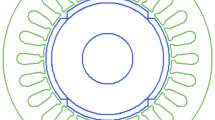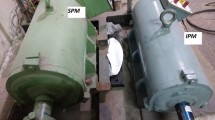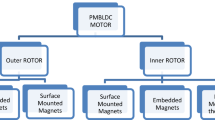Abstract
This paper presents a novel and exhaustive investigation involving in-depth analysis, performance evaluation and comparative study of two 0.75 hp, 4-pole, 1500 rpm laboratory prototypes of Brushless DC (BLDC) motors of identical nominal ratings with surface and interior permanent magnet rotor structures having the same stator and winding (integral slot distributed winding). Both the motors were designed and developed in the lab. The major electrical variables (such as rated power, speed, voltage, current, number of poles, etc.) and the stator (such as core material, stator lamination, stack length, winding pattern and wire gauge) of the fabricated prototypes have also been kept identical to pin-point the direct influence of the two different rotor configurations (viz., surface vs interior permanent magnet) on the parameters, performance and operation of these BLDC motors. Additionally, to ensure unbiased basis for appropriate comparison, the overall volumes of magnets/pole in both the motors have also been kept similar. A detailed comparison of different quantities like air-gap flux density distribution, THD in induced voltage, torque ripple, losses and efficiency, torque–speed characteristics with field-weakening capability, steady state parameters at different operating conditions, etc. has been conducted for the said motors and the salient points duly highlighted. The vulnerability of the permanent magnets to demagnetisation based on armature reaction, particularly during a sudden fault, has also been investigated in both the cases. The theoretically determined parameters and analytically evaluated performance figures have been verified through standard FEM packages, and later validated experimentally on the fabricated prototypes. Very good mutual agreement has been observed between predicted and experimental values.




























Similar content being viewed by others
References
Pillay P and Krishnan R 1991 Application characteristics of permanent magnet synchronous and brushless DC motors for servo drives. IEEE Trans. Ind. Appl. 27(5): 986–996
Lee T Y, Seo M K, Kim Y J and S Y Jung 2016 Motor design and characteristics comparison of outer-rotor-type BLDC motor and BLAC motor based on numerical analysis. IEEE Trans. Appl. Supercond. 26(4): 5205506–5205510
Bertoluzzo M, Buja G, Keshri R K and Menis R 2015 Sinusoidal versus square-wave current supply of PM brushless DC drives: a convenience analysis. IEEE Trans. Ind. Electron. 62(12): 7339–7349
Jahns T M 1984 Torque production in permanent-magnet synchronous motor drives with rectangular current excitation. IEEE Trans. Ind. Appl. 20(4): 803–813
Shen J X, Zhu Z Q and Howe D 2004 Sensorless flux-weakening control of permanent-magnet brushless machines using third harmonic back EMF. IEEE Trans. Ind. Appl. 40(6): 1629–1636
Pillay P and Krishnan R 1989 Modeling, simulation, and analysis of permanent-magnet motor drives. II. The brushless DC motor drive. IEEE Trans. Ind. Appl. 25(2): 274–279
Jahns T M 1994 Motion control with permanent-magnet AC machines. IEEE Proc. 82(8): 1241–1252
Chung S U, Kim J W, Chun Y D, Woo B C and Hong D K 2015 Fractional slot concentrated winding PMSM with consequent pole rotor for a low-speed direct drive: reduction of rare earth permanent magnet. IEEE Trans. Energy Convers. 30(1): 103–109
Kim H K and Hur J 2017 Dynamic characteristic analysis of irreversible demagnetization in SPM- and IPM-type BLDC motors. IEEE Trans. Ind. Appl. 53(2): 982–990
Finken T, Hombitzer M and Hameyer K 2010 Study and comparison of several permanent-magnet excited rotor types regarding their applicability in electric vehicles. In: Proceedings of Emobility – Electric Power Train, INSPEC Accession No. 11697279
Reddy P B, El-Refaie A M, Huh K K, Tangudu J K and Jahns T M 2012 Comparison of interior and surface PM machines equipped with fractional-slot concentrated windings for hybrid traction applications. IEEE Trans. Energy Convers., 27(3): 593–602
EL-Refaie A M and Jahns T M 2005 Optimal flux weakening in surface PM machines using fractional-slot concentrated windings. IEEE Trans. Ind. Appl. 41(3): 790–800
Magnussen F, Thelin P and Sadarangani C 2004 Performance evaluation of permanent magnet synchronous machines with concentrated and distributed windings including the effect of field-weakening. In: Proceedings of the IEEE Conference on PEMD
Chen H, Qu R, Li J and Zhao B 2014 Comparison of interior and surface permanent magnet machines with fractional slot concentrated windings for direct-drive wind generators. In: Proceedings of the IEEE International Conference on Electrical Machines and Systems (ICEMS), INSPEC Accession Number 14864915
Roshanfekr P, Thiringer T, Alatalo M and Lundmark S 2012 Performance of two 5 MW permanent magnet wind turbine generators using surface mounted and interior mounted magnets. In: Proceedings of the XXth International Conference on Electrical Machines, INSPEC Accession Number 13119312
Zhao N and Liu W 2015 Loss calculation and thermal analysis of surface-mounted PM motor and interior PM motor. IEEE Trans. Magn. 51(11): 8112604
Sekerak P, Hrabovcova V, Pyrhonen J, Kalamen L, Rafajdus P and Onufer M 2013 Comparison of synchronous motors with different permanent magnet and winding types. IEEE Trans. Magn. 49(3): 1256–1263
Kim I G, Cho S Y etal 2013 A study on the torque ripple improvement of a BLDC motor via skewed magnet. Proceedings of the IEEE International Conference on Electrical Machines and Systems (ICEMS), INSPEC Accession Number 14142315
Hanselman D C 1994 Brushless permanent magnet motor design. McGRAW HILL Inc, Newyork
Hendershot J R and Miller T J E 1994 Design of brushless permanent magnet motors. Magna Physics Publishing and Oxford University Press, Oxford
Mukherjee P and Sengupta M 2014 Design, analysis and fabrication of a brush-less DC Motor. In: Proceedings of the IEEE International Conference on PEDES
Li J, Xu Y, Zou J, Wang Q and Liang W 2015 Analysis and reduction of magnet loss by deepening magnets in interior permanent-magnet machines with a pole-slot ratio of \(\frac{2}{3}\). IEEE Trans. Magn. 51(11): Seq. no. 8112004
Say M G 1983 The performance and design of alternating current machine, 1st Indian edition. CBS Publishers & Distributors. First Indian edition, New Delhi
Dexter Magnetic Technologies, https://www.dextermag.com/products/permanent-magnets/samarium-magnets-s2816/
Dexter Magnetic Technologies, https://www.dextermag.com/products/permanent-magnets/neodymium-iron-boron-magnets/
Liu X, Chen H, Zhao J and Belahcen A 2016 Research on the performances and parameters of interior PMSM used for electric vehicles. IEEE Trans. Ind. Electr. 63(6): 3533–3545
Meessen K J, Thelin P, Soulard J and Lomonova E A 2008 Inductance calculations of permanent-magnet synchronous machines including flux change and self- and cross-saturations. IEEE Trans. Magn. 44(10): 593–602
O’Kelly D and Simmons S 1968 Generalized electrical machine theory. McGraw-Hill Publisher, London
Soong W L and Miller T J E 1994 Field-weakening performance of brushless synchronous AC motor drives. IEE Proc. – Electr. Power Appl. 141(6): 331–340
Dutta R and Rahman M F 2006 A comparative analysis of two test methods of measuring d- and q-axes inductances of interior permanent-magnet machine. IEEE Trans. Ind. Electron. 42(11): 3712–3718
Zhu L, Jiang S Z, Zhu Z Q and Chan C C 2009 Analytical methods for minimizing cogging torque in permanent-magnet machines. IEEE Trans. Magn. 45(4): 2023–2031
Wang D, Wang X, Kim M K and Jung S Y 2012 Integrated optimization of two design techniques for cogging torque reduction combined with analytical method by a simple gradient descent method. IEEE Trans. Magn. 48(8): 2265–2276
Dosiek L and Pillay P 2007 Cogging torque reduction in permanent magnet machines. IEEE Trans. Ind. Appl. 43(6): 1565–1571
Morimoto S, Takeda Y, Hirasa T and Taniguchi K 1990 Expansion of operating limits for permanent magnet motor by current vector control considering inverter capacity. IEEE Trans. Ind. Appl. 26(5): 866–871
Jahns T M 1987 Flux-weakening regime operation of an interior permanent-magnet synchronous motor drive. IEEE Trans. Ind. Appl. 23(4): 681–689
Ionel D M, Eastham J F, Miller T J E and Demeter E 1998 Design considerations for permanent magnet synchronous motors for flux weakening applications. IEE Proc. – Electr. Power Appl. 145(5): 435–440
Bianchi N and Bolognani S 1997 Parameters and volt–ampere ratings of a synchronous motor drive for flux weakening application. IEEE Trans. Power Electron. 12(5): 895–903
Schiferl R F and Lipo T A 1990 Power capability of salient pole permanent magnet synchronous motors in variable speed drive applications. IEEE Trans. Ind. Electron. 26(1): 115–123
Deng F 1999 An improved iron loss estimation for permanent magnet brush-less machinesIEEE Trans. Energy Convers. 14(4): 1391–1395
Chunting M, Slemon G R and Bonert R 2003 Modelling of iron losses of permanent-magnet synchronous motors. IEEE Trans. Ind. Appl. 39(3): 734–742
Acknowledgements
The authors wish to thank the staff of M/s GE motors Pvt. Ltd, Sheorapuli, WB, and Mr. Kausik Pyne, in particular, for the fabrication support received. The authors also acknowledge the funds received from CSIR, GoI (for manpower support) and Nampet-II, MeitY, GoI (for fabrication support), and the support received from the research colleagues at the Advanced Power Electronics Laboratory, Department of Electrical Engineering, IIEST, Shibpur, towards this work. The co-operation of the authorities at the IIEST, Shibpur, is also thankfully acknowledged.
Author information
Authors and Affiliations
Corresponding author
Rights and permissions
About this article
Cite this article
Mukherjee, P., Paitandi, S. & Sengupta, M. Comparative analytical and experimental study of fabricated identical surface and interior permanent magnet BLDC motor prototypes. Sādhanā 45, 26 (2020). https://doi.org/10.1007/s12046-019-1264-0
Received:
Accepted:
Published:
DOI: https://doi.org/10.1007/s12046-019-1264-0




